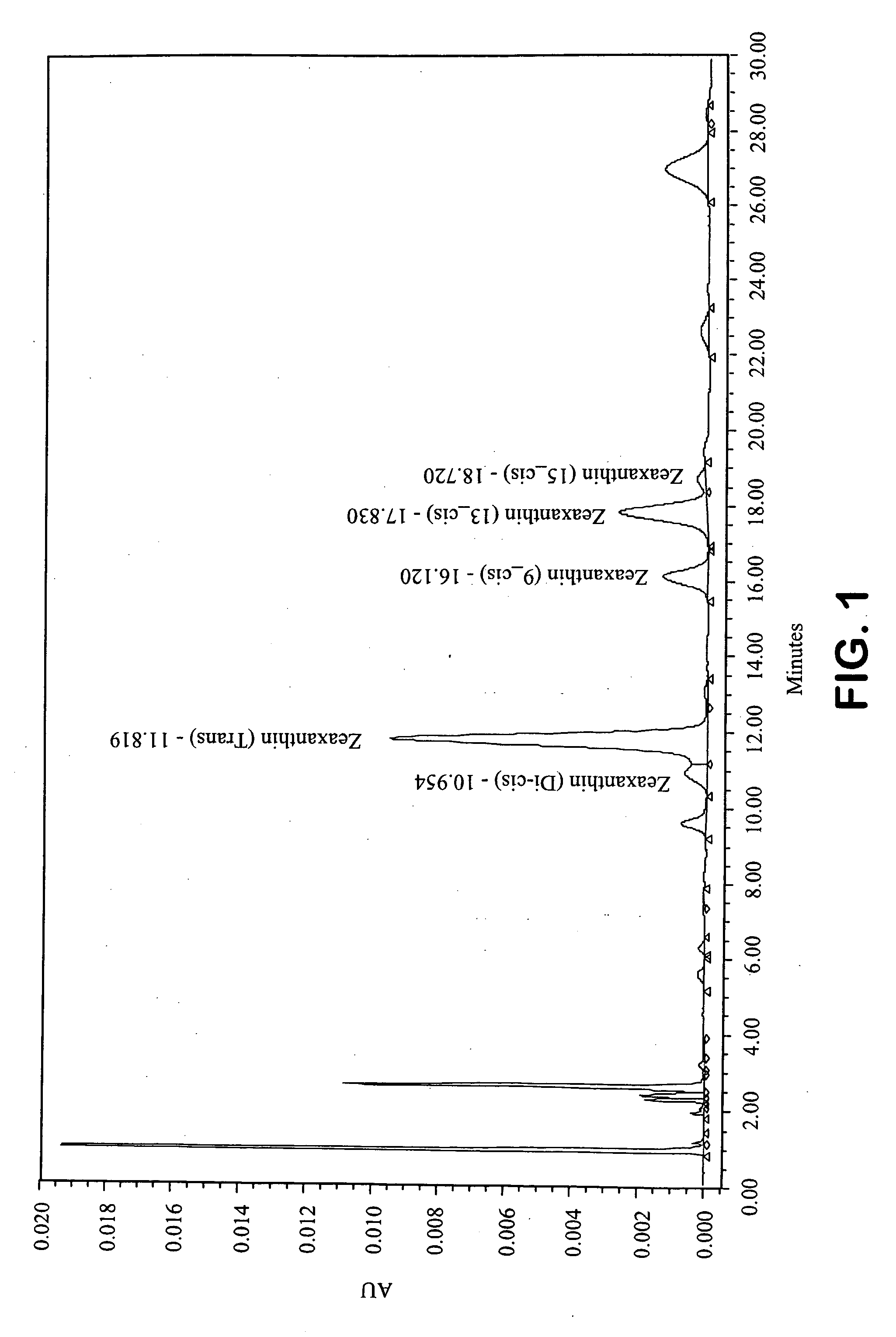Process of converting esterified xanthophylls from capsicum to non-esterified xanthophlls in high yields and purities
a technology of esterified xanthophylls and capsicum, which is applied in the field of conversion of esterified (nonfree form) xanthophylls from capsicum to nonesterified (free form) xanthophylls in high yield and purities, can solve the problems of lutein cannot be synthesized by humans and animals, fatty acids are susceptible to damage, and eye tissue damage, etc., to achieve high yield and high purity
- Summary
- Abstract
- Description
- Claims
- Application Information
AI Technical Summary
Benefits of technology
Problems solved by technology
Method used
Image
Examples
example 1
[0209]A series of reactions were carried out in order to investigate the effect of base type (hydroxide vs. methoxide), base amount, methanol amount, presence or absence of an alkane (hexane), and temperature (room temperature or reflux). Each reaction was carried out as follows: To a three-neck reaction flask was added 20 g of paprika oleoresin containing 2.7% total zeaxanthin comprised of 1.9% trans-zeaxanthin and 0.8% cis-zeaxanthin (mixture of isomers), along with the other reagents and proportions shown in the table below. Hexanes and methanol were both HPLC grade from Fisher scientific. When potassium hydroxide was used as the base, it was added as a 45% aqueous solution. When sodium methoxide (NaOMe) was used, it was added as a 30% solution in methanol. After the reagents were added, positive nitrogen pressure was promptly applied to the flask, and the reactants continuously mixed with an overhead stirrer for the duration of the reaction. With the exception of reactions 9 and...
example 2
[0212]A reaction was carried out using the same reactants at the same proportions under the same conditions as reaction 19 in the table in Example 1. The procedure was identical for the first 24 hrs as described for reaction 19, but after refluxing for 24 hours, the mixture was allowed to settle for 1 hour at which time the upper hexane layer was decanted away. The remaining lower phase was washed twice by partitioning with water (30 mL for each wash). In each case the lower aqueous phase was discarded and after the second water wash, methanol (75 mL) was added to the remaining upper phase. The mixture was then distilled to remove the remaining hexanes and then refluxed for five hours. The mixture was then allowed to cool and was centrifuged and decanted to afford a supernatant and a crude precipitate. The crude precipitate was desolventized and HPLC analysis showed that 81.2% of the total zeaxanthin input was isolated in the precipitate, including 113.7% of the input all-trans-zeax...
example 3
[0213]A demonstration that, among other things, some cis zeaxanthin is converted to trans during the saponification, and that additional cis-zeaxanthin can be converted to trans by incorporating an additional reflux step.
[0214]In a procedure similar to that described in Example 2 after distilling away the hexane, the mixture was refluxed for a total of 40 hours and the content of zeaxanthin isomers was monitored by HPLC as a function of time. The results are given in the table below. After refluxing for 40 hours the mixture was allowed to cool, then centrifuged to afford a supernatant and a crude precipitate. The crude precipitate was washed with methanol (4× by weight of crude precipitate) centrifuged and decanted to afford a wash solution and a refined precipitate. After desolventization, the powder was 59.0% pure zeaxanthin corresponding to a yield of 71%. The supernatant and the wash solution were both analyzed for zeaxanthin content and >99% of input zeaxanthin was accounted fo...
PUM
| Property | Measurement | Unit |
|---|---|---|
| Temperature | aaaaa | aaaaa |
| Temperature | aaaaa | aaaaa |
| Temperature | aaaaa | aaaaa |
Abstract
Description
Claims
Application Information
 Login to View More
Login to View More - R&D
- Intellectual Property
- Life Sciences
- Materials
- Tech Scout
- Unparalleled Data Quality
- Higher Quality Content
- 60% Fewer Hallucinations
Browse by: Latest US Patents, China's latest patents, Technical Efficacy Thesaurus, Application Domain, Technology Topic, Popular Technical Reports.
© 2025 PatSnap. All rights reserved.Legal|Privacy policy|Modern Slavery Act Transparency Statement|Sitemap|About US| Contact US: help@patsnap.com



